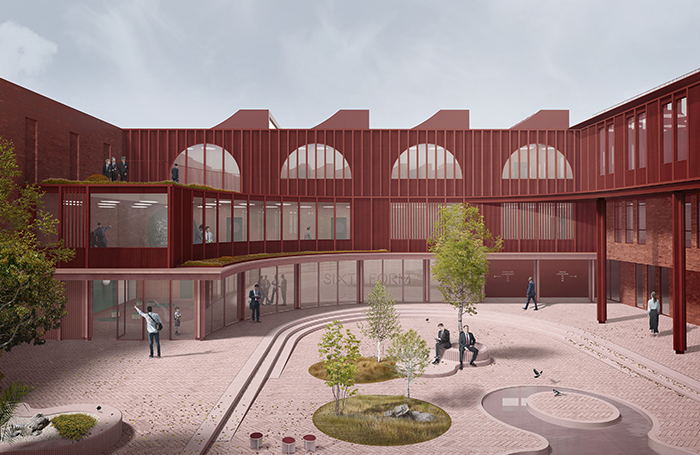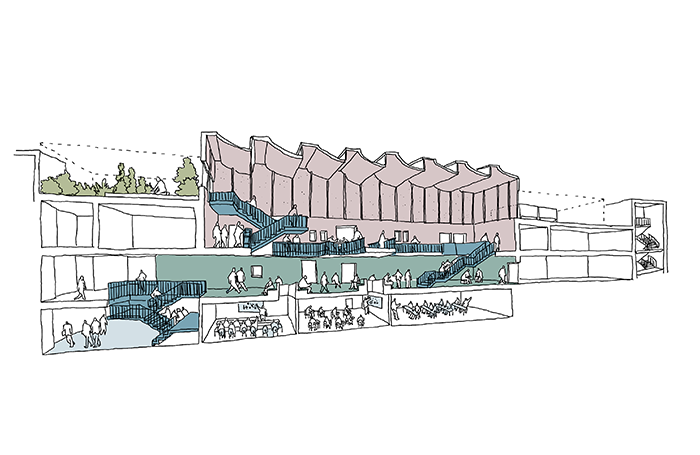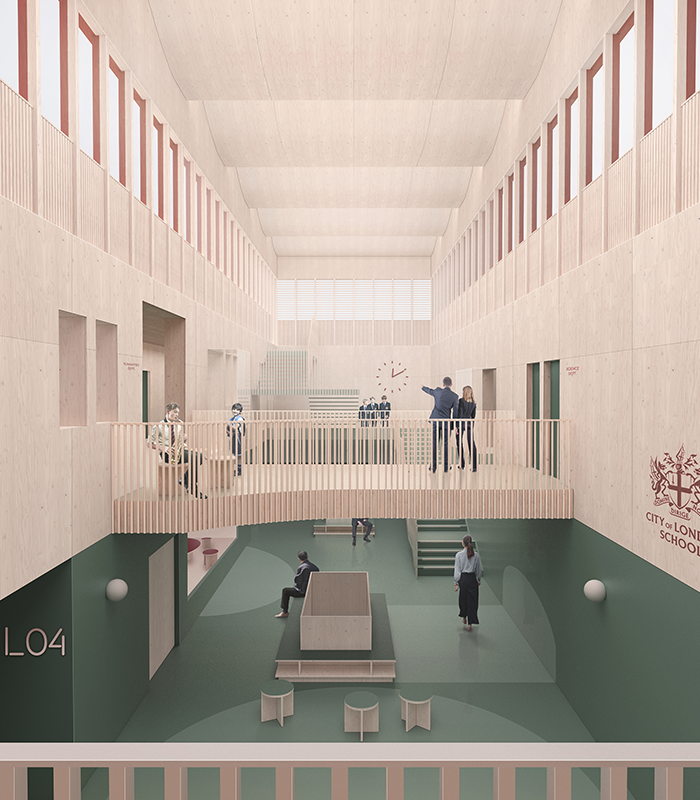Freehaus and Morris + Company are both London-based RIBA Chartered Practices who have made a conscious effort to build an ethos of collaboration into the way they practice.
They have recently won an international competition for a £19 million revamp of the City of London School. In a brief that called for net zero carbon, the competition scheme was co-authored by Morris + Company and Freehaus Architects through a continuously collaborative design process which will remain throughout the development of the design and its realisation.
RIBA London asked them a few questions about how their collaboration came about and the processes they have adopted to collectively create a winning scheme.

How did the collaboration come about?
Morris + Company: Freehaus had been on our radar since winning the Africa Centre competition. We were introduced to them during a large design competition in Camden via DSDHA with whom we've worked quite a bit. We came away feeling that our practices would have complementary skills and common values that could produce a strong collaboration with the right kind of brief. When the City of London School competition emerged, it felt like a good fit for both practices - we are different enough in terms of scale and expertise that I think we can both learn from each other.
Freehaus: Morris + Company has long been a practice we admire. We jumped at the opportunity to collaborate again with them on the City of London School. The brief offered a wealth of opportunities for both practices to utilise their respective skill sets and to support one another collaboratively, so we were both humbled and honoured that they wanted to co-author this project with us.
What are the main benefits of collaborating?
Freehaus: From the client’s perspective our collaboration or "super team" approach offers a tailored solution that can perform at the macro and micro scales of this very specific and complex brief, requiring new build and refurbishment outputs. The added energy of collaboration always requires careful management but when channelled correctly we really believe it delivers added value beyond the mechanics of the brief, and in this instance will enhance the school community experience and end user legacy.
Morris + Company: We talk about this a lot at Morris + Company - specifically the idea of "collective intelligence," where the team becomes a synchronous hive brain that is greater than the sum of its parts - this ultimately leads to better design outcomes and ultimately added value for clients. Collaborative working can exaggerate this benefit. Collaboration can allow the practice to broaden our knowledge and to harness specialisms and expertise that we may not have in house - all of which benefits the client and project too.
Freehaus: The collaboration exposes both practices to new ways of working and design methodologies that when combined, enrich our approach. For Freehaus, this collegiate relationship is one that offers us a sense of mentorship as we look to grow our practice, the sophistication of our systems and the scale of the community and civic projects we aspire to deliver. In turn, we hope that Freehaus can offer fresh design thinking and our practice’s specialisms, such as environmental design, in return.

How do you embed collaboration into your practice ethos?
Morris + Company: We describe the practice as a "company of voices," which means we are seeking an inclusive environment where the "best idea wins" and where everyone in the practice feels able to express themselves and bring their experiences to bear on all aspects of design. We’ve enshrined it as a practice value in our 10 year vision statement.
Freehaus: Collaboration is an ambition that sits at the very core of our founding principles. We believe that our projects should be rooted in context and as such, we are advocates of working with local people to make sure all voices are heard and that our projects speak of and for their communities. Working with end user clients is something we are therefore passionate about. From our roots in community projects, we are also keen to ensure that all projects provide social value. We work hard to engage with under-represented and hard to reach groups to create collaborative and co-design opportunities for members of the local community. On the City of London School, we will be engaging with pupils from the Eco Schools Group to help shape our environmental legacy and provide a cultural capital exchange programme to create pathways into the profession.
What advice would you give a smaller practice looking to collaborate?
Freehaus: It is important to research practices that align with your own practice ethos. Why not set up an introduction to present your work and yourself as a practitioner? Look out for opportunities where partnerships are welcome and pitch an idea to a practice you would like to collaborate with. Even if you don’t move forwards with the idea, you will at least make a positive introduction, so give it a go. Define the roles and responsibilities of each collaborative partner at an early stage and before the competition is submitted. Don’t get pigeonholed into doing parts of the project that no one else wants to do. For collaboration to work effectively all parties need to benefit. Like any relationship trust your gut, you know when it’s right and also equally as important - when it’s wrong.
What advice would you give to a larger practice thinking about collaborating?
Morris + Company: While we think there are potentially long term benefits of collaboration in terms of design, is not without significant complexity and administrative burden. It's likely that the arrangement will involve some natural inefficiencies so it's important to set up open communication channels and to broaden your definition of "profit" beyond simply the bottom line. Collaborating with other practices can improve the quality and social value impacts of design work and also provide essential bridges for the next generation of practice.

Is there anything about your practice that makes you more conducive to collaboration?
Freehaus: We encourage all of our team to be individuals because individual passion drives our collective vision. In doing so, we give a platform to personality, individual interests and specialisms, which ultimately gives Freehaus a unique voice. Interests and specialisms enable us to enter a collaborative arena with greater authority and awareness. We are not just perceived as a small practice but rather as a growing and ambitious practice that has specialist skills. The process of engaging outside the boundaries of practice also hones collaborative skills, adaptability, and keeps our team grounded and mindful of others.
Morris + Company: While there is still progress to be made, in recent years we've moved substantially towards a practice culture that is as open, transparent, and inclusive as possible. In team settings, I think this helps because everything is discussed in the open. We apply this non-adversarial attitude as much as possible to projects and this allows potential conflicts and issues to rise to the surface very quickly and the burden of resolving them to be shared.
How is the collaboration formally structured for this project?
Freehaus: Morris + Company are the lead architect and are ultimately the architect in contract with the City of London Corporation. Freehaus are sub-consulted via standards terms to Morris + Company with a collateral warranty to the City of London Corporation. Morris + Company also carry a higher level of PI and it has been agreed with their insurers that Freehaus will hold a lesser PI cover as this is proportional to our outputs and responsibility on the project. For the City of London School project, Morris + Company are leading the extension and strategic interventions to the building and Freehaus is leading the internal fit out and engagement strategy.
This is underpinned by a responsibility matrix that we have developed together. In this instance, both practices lead and assist with different aspects of the project which brings out the best qualities in each team and makes the process an enriching learning experience for both.
The notion of co-authorship also affords greater crossover and interaction amongst the team on a day to day basis, which we believe is generous but also exemplifies the positive opportunity that collaboration can afford. What is important is that the mechanics are solid, providing a framework in which to flex and take reference from. This has resulted in a cordial yet energetic and colligate design arena.
Morris +Company: The wording of the Sub Consultancy Agreement is adjusted to be "back to back" with the head appointment. To facilitate the inclusion of a smaller emerging practice there is a difference in the total PI limit provided by each party, but importantly the scope of responsibilities has been agreed upon to reflect this so that coverage is commensurate with the risks of the design responsibility. To formalise this, a clear contractual split of design responsibilities was agreed in outline at the bid stage and then this becomes embedded in the sub-c form with a scope split table. In order for us to essentially adopt design outputs into our design information for the overall project, design work from sub-consulted team members has to undergo the same design review, technical review, and QA processes of any other project in the practice. It's probably easiest to think of the two practices as a kind of single "super practice."
How did collaborating with another practice change the design process?
Morris + Company: The main difference we’ve felt is that by sharing all design reviews, we have probably been forced at times to view our work more objectively and be more self-reflective about what we're trying to achieve with the design. We have had to find new ways of describing design that feels like a good fit for both practices and is inherently "new" for both parties. You also get a different reaction when critiquing design with other practices, which can unearth solutions we wouldn't have arrived at alone. In some ways, we are both able to try out slightly augmented design identities which represent both practices - which is an intriguing experiment.
What have you learned from Freehaus during this project?
Morris + Company: While Freehaus are strong all-rounders, they have what we would consider "specialisms" in house - specifically Passivhaus, conservation, and interiors expertise. They have a slightly different approach to engagement too which is beneficial when briefing with a school. So we are probably learning a lot from them in these particular areas, but in general - they are just really bold and thoughtful designers who bring great ideas to all settings and so we're learning lots from them.
Are you seeing more clients seeking collaborations?
Morris + Company: Yes, in the last year or two we've seen clients actively urging architects to bring forward collaborative teams and they have tailored their briefs and procurement scoring to reinforce this priority. We perceive that public sector clients in particular see collaboration as a route towards employing architects from more diverse backgrounds that are less "establishment" in their size and leadership. The architecture profession is not representative of society and our cities need design authorship from a wider pool of people than we are currently seeing. As an established medium sized practice with a great range of client relationships across sectors we can see there is a responsibility to be a bridge and help to build connections between clients that can have a big social impact on our cities and the emerging generation of young practices.
To find out more about collaboration and how you can connect via our Collaboration Network, visit our Collaboration Network page.









